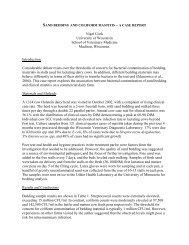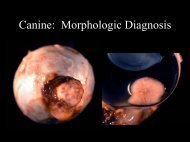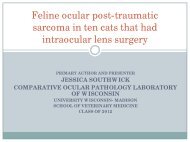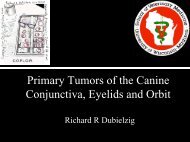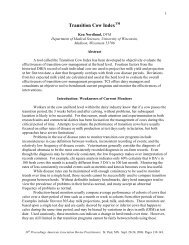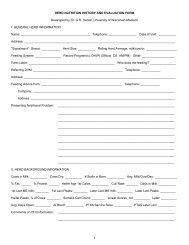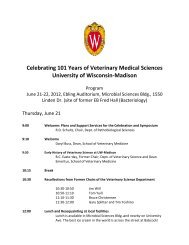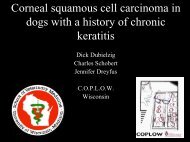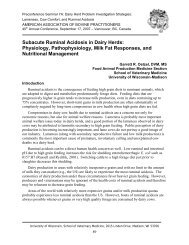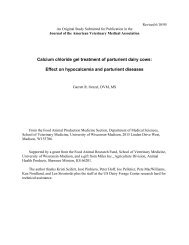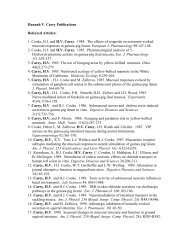Salmonellosis in Cattle: Is There Anything New - University of ...
Salmonellosis in Cattle: Is There Anything New - University of ...
Salmonellosis in Cattle: Is There Anything New - University of ...
You also want an ePaper? Increase the reach of your titles
YUMPU automatically turns print PDFs into web optimized ePapers that Google loves.
Preconvention Sem<strong>in</strong>ar 7: Dairy Herd Problem Investigation Strategies<br />
Feces<br />
Feed<br />
Water<br />
Under appropriate moisture, temperature and pH conditions, the organism can replicate<br />
about every 30 m<strong>in</strong>utes<br />
Salmonella spp. can also be <strong>in</strong>troduced <strong>in</strong> contam<strong>in</strong>ated feeds. The ban on feed<strong>in</strong>g<br />
rum<strong>in</strong>ant prote<strong>in</strong> has reduced this risk but Salmonella can contam<strong>in</strong>ate animal and<br />
vegetable fats fed to cattle.<br />
Sick cows and asymptomatic shedders<br />
The most recent studies show that approximately 5% <strong>of</strong> apparently healthy dairy cows<br />
may be shedd<strong>in</strong>g the organism <strong>in</strong> their feces and that approximately 20% <strong>of</strong> all sick cows<br />
on the cull list shed Salmonella spp. This makes the on-farm location <strong>of</strong> these cattle as<br />
well as cattle with obvious diarrhea very important because cl<strong>in</strong>ically affected animals<br />
shed more than 10 14 organisms per day (<strong>in</strong>fectious dose 10 9 -10 11 organisms).<br />
♦ Survival outside animals<br />
In the environment, it survives for 4 to 5 years <strong>in</strong> water, soil, dust, moist areas out <strong>of</strong> direct<br />
sunlight and on or with<strong>in</strong> foods. S. dubl<strong>in</strong> can survive <strong>in</strong> dry feces for over a year, however<br />
freez<strong>in</strong>g at –4 F kills 85% <strong>of</strong> Salmonella spp. <strong>in</strong> 2 days.<br />
Crops irrigated with salmonellae-contam<strong>in</strong>ated wastewater will lead to contam<strong>in</strong>ation forages and<br />
water sources.<br />
Render<strong>in</strong>g kills salmonellae; however post process<strong>in</strong>g contam<strong>in</strong>ation accounts for 50% <strong>of</strong><br />
contam<strong>in</strong>ation <strong>of</strong> rendered feed products.<br />
♦ Carrier Animals<br />
Infection with a host-adapted Salmonella stra<strong>in</strong> (S. dubl<strong>in</strong> <strong>in</strong> cattle) can result <strong>in</strong> a cyclic, endemic<br />
disease that is ma<strong>in</strong>ta<strong>in</strong>ed on a farm by carrier animals shedd<strong>in</strong>g <strong>in</strong> the feces and/or milk. The carriers<br />
can shed constantly or <strong>in</strong>termittently.<br />
<strong>Cattle</strong> – chronically affected carriers may shed 10 8 to 10 9 salmonellae per day <strong>in</strong> feces and 10 2 to 10 5<br />
organisms per ml <strong>of</strong> milk.<br />
S<strong>in</strong>ce Salmonella spp. can cross from one species to another, other potential animal sources <strong>in</strong>clude<br />
dogs, birds, cats, people and pigs. Flies also pose a risk for spread. Fomites – feces and oropharyngeal<br />
secretions on the follow<strong>in</strong>g can be significant sources <strong>of</strong> cross contam<strong>in</strong>ation between cattle:<br />
<strong>University</strong> <strong>of</strong> Wiscons<strong>in</strong>, School <strong>of</strong> Veter<strong>in</strong>ary Medic<strong>in</strong>e, 2015 L<strong>in</strong>den Drive, Madison, WI 53706<br />
2



